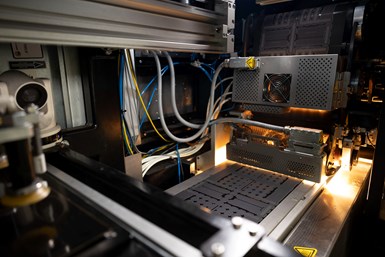Evolve Additive Solutions Partners With Alphacam to Provide STEP Parts Production in Europe
The partnership enables the distributive manufacturing of printed parts using STEP technology, thereby broadening global access to this additive process.
Evolve’s STEP process uses technology that borrows from high-speed imaging to rapidly apply layers of material. It can print parts in batches at a deposition rate up to 286 cubic inches per hour. The horizontal image at the top of the page shows a component made using STEP that would otherwise be injection molded. Photo: Evolve Additive Solutions
Evolve Additive Solutions, provider of industrial 3D printing solutions and inventor of the Selective Thermoplastic Electrophotographic Process (STEP), has developed a strategic partnership with Alphacam to offer STEP-manufactured parts as a service to customers throughout Europe.
STEP is an additive manufacturing technology (AM) that addresses the manufacturing constraints in accuracy, scalability and engineering-grade materials by other technologies in the market. Alphacam will combine its industry expertise, experience in printing plastic parts and customer relationships with its adoption of Evolve’s Scaled Volume Production (SVP) platform to produce and deliver fully dense, high-fidelity thermoplastic parts with near injection molding surface finish and properties.
This marks the second partnership of this kind introduced by Evolve as part of its mission to establish STEP production centers of excellence around the world. The company aims to increase access to STEP technology as an additive process that can deliver on the material properties, accuracy and scalability required to print end-use parts at production volumes and replace traditional manufacturing methods for more applications. The first partnership with Fathom Digital Manufacturing currently offers STEP parts in North America.
“We have experienced increasing demand for STEP parts in Europe, especially in automotive, consumer electronics, medical device and retail markets, as well as with fluid and airflow applications,” says Jeff Hanson, Evolve’s senior vice president of Go-to-Market. “Given their rich history and leadership in additive manufacturing, Alphacam is the ideal partner to bring STEP technology to European industrial sectors.”
Alphacam says it works to remain at the forefront of advanced manufacturing technologies and services. “I believe STEP technology is uniquely positioned to deliver on additive manufacturing’s quest toward production quality and scale, and we are excited to now be able to deliver this value by way of STEP parts to our customers,” says Michael Junghanss, Alphacam’s managing partner.
- Read about Evolve Additive Solutions’ enhanced portfolio with global parts service, two more materials. New parts production service and two more material offerings enable greater commercial access to Evolve’s STEP technology, which can expand application development for STEP production around the world.
- Watch this Video showing STEP 3D Printing at Fathom Manufacturing. Fathom Manufacturing's Fremont Technology Center now houses the first STEP 3D printer in commercial use. This video looks at how the platform works and use cases that the contract manufacturer is identifying.
- Check out this article which considers if additive manufacturing can compete with conventional manufacturing on cost? When it can, says Evolve Additive Solutions, the design advantages of AM find their way in. The company is beginning to ship its high-speed AM system for polymer part production.
Related Content
Aircraft Ducts 3D Printed in Composite Instead of Metal: The Cool Parts Show #68
Eaton’s new reinforced PEKK, tailored to aircraft applications, provides a cheaper and faster way to make ducts compared to formed aluminum.
Read MoreWhat Does Additive Manufacturing Readiness Look Like?
The promise of distributed manufacturing is alluring, but to get there AM first needs to master scale production. GKN Additive’s Michigan facility illustrates what the journey might look like.
Read MoreCopper, New Metal Printing Processes, Upgrades Based on Software and More from Formnext 2023: AM Radio #46
Formnext 2023 showed that additive manufacturing may be maturing, but it is certainly not stagnant. In this episode, we dive into observations around technology enhancements, new processes and materials, robots, sustainability and more trends from the show.
Read MoreActivArmor Casts and Splints Are Shifting to Point-of-Care 3D Printing
ActivArmor offers individualized, 3D printed casts and splints for various diagnoses. The company is in the process of shifting to point-of-care printing and aims to promote positive healing outcomes and improved hygienics with customized support devices.
Read MoreRead Next
Profilometry-Based Indentation Plastometry (PIP) as an Alternative to Standard Tensile Testing
UK-based Plastometrex offers a benchtop testing device utilizing PIP to quickly and easily analyze the yield strength, tensile strength and uniform elongation of samples and even printed parts. The solution is particularly useful for additive manufacturing.
Read More3D Printed Polymer EOAT Increases Safety of Cobots
Contract manufacturer Anubis 3D applies polymer 3D printing processes to manufacture cobot tooling that is lightweight, smooth and safer for human interaction.
Read MoreCrushable Lattices: The Lightweight Structures That Will Protect an Interplanetary Payload
NASA uses laser powder bed fusion plus chemical etching to create the lattice forms engineered to keep Mars rocks safe during a crash landing on Earth.
Read More





















